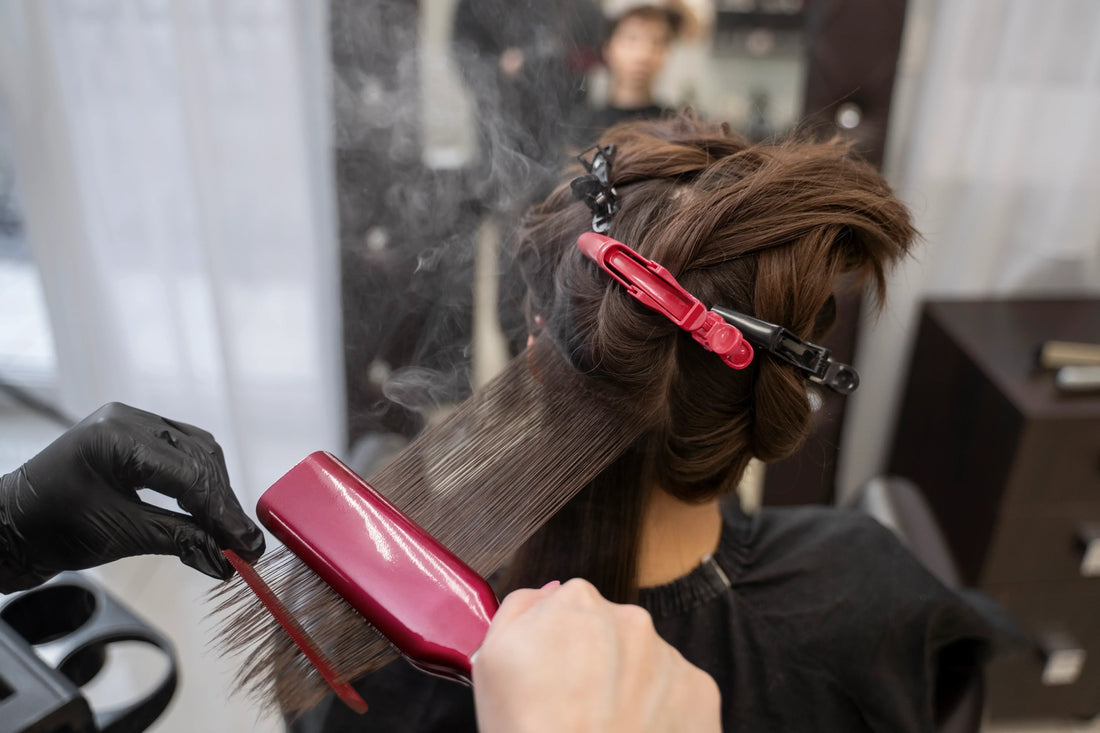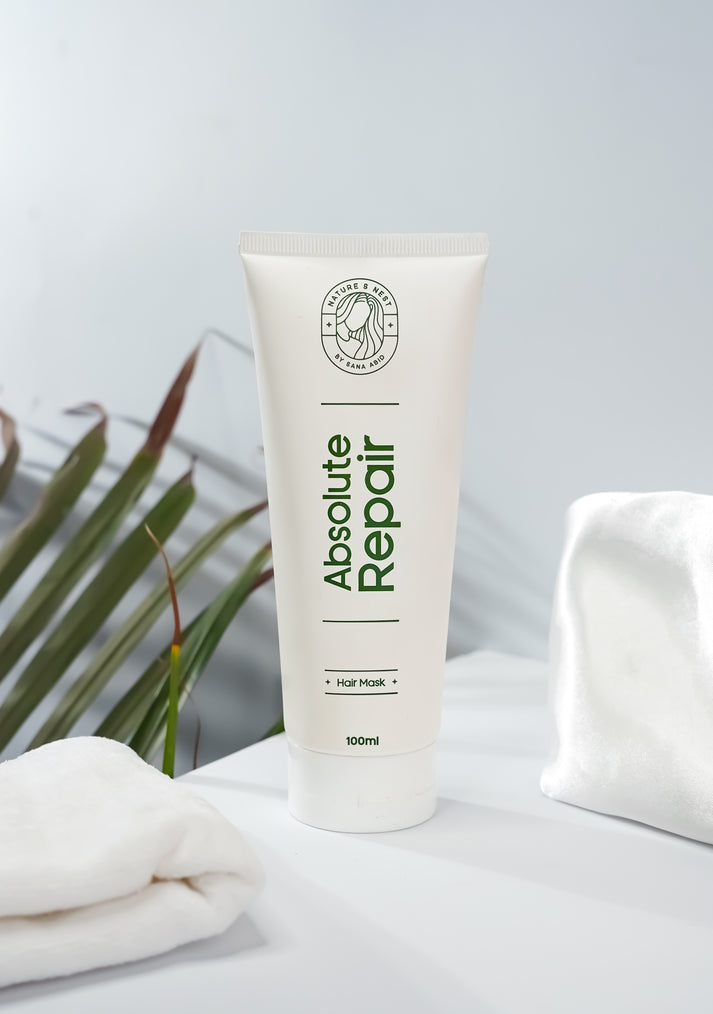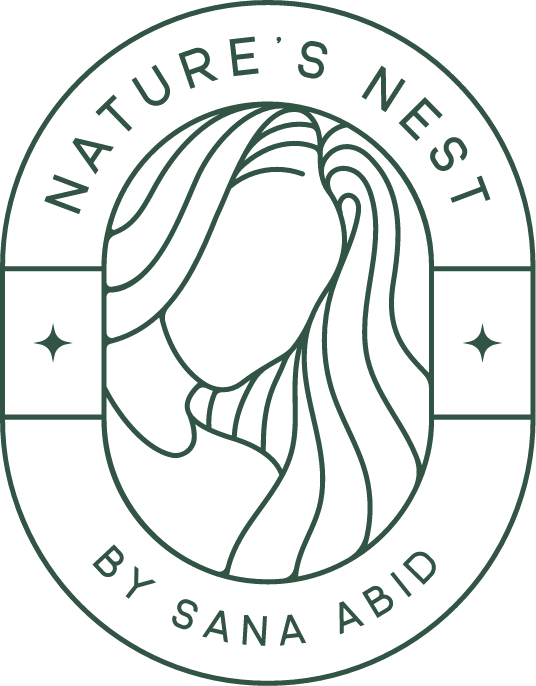
Hair Rebonding: Benefits, Process, Side Effects & Aftercare Guide
Share
Introduction: Hair Rebonding and Straightening

Hair rebonding and hair straightening are two of the most popular treatments in the beauty industry for achieving smooth, sleek, and frizz-free hair. While both treatments work to transform your hair’s texture, they serve different purposes and deliver distinct results.
Hair rebonding is a permanent hair straightening solution that restructures the internal protein bonds of your hair. This chemical treatment alters the disulfide bonds in your hair. This change creates sleek, smooth strands. With proper care, these results can last 6 to 12 months.
Hair rebonding is different from temporary straightening methods. While those methods last a few days to a few months, rebonding gives long-lasting results. For permanent hair straightening and less daily styling time, hair rebonding is a good choice.
Hair straightening is a temporary solution that uses heat or chemicals to smooth hair. These treatments give quick results. Examples include keratin treatments, Brazilian blowouts, and flat irons.
However, unlike hair rebonding, these methods need regular upkeep and do not last as long. Straightening is ideal for those who want to reduce mild frizz or smooth their hair without making permanent changes.
Learn about its features, how it is different from straightening, and what to expect for care, and results.
What is Hair Rebonding?
Hair rebonding is a chemical treatment. It permanently changes the structure of your hair. This happens by breaking and reshaping the internal protein bonds, known as disulfide bonds. The results typically last 6 to 12 months, depending on your aftercare routine.
The process starts with a hair-rebonding cream. This cream often has ingredients like ammonium thioglycolate. These ingredients help to loosen the natural structure of the hair.
Once you break the bonds, use a flat iron to apply heat that helps reshape the hair. This process locks the hair into its new style. The final step is the application of a neutralizer for hair, which ensures the new structure holds.
Hair rebonding offers a low-maintenance solution. It significantly reduces daily styling time and provides a polished, salon-quality look.
Benefits of rebonding hair is that it reduces the need for heat styling tools. This helps prevent long-term damage from too much flat ironing or blow-drying.
However, there are a few things to keep in mind after undergoing hair rebonding. The treated hair stays straight, but new hair will grow with its natural texture. You will need touch-ups every few months to keep your hairstyle looking uniform.
Taking care of your hair after rebonding is important. It keeps your hair smooth, shiny, and safe from damage.
Use products of Nature's Nest like:

Nature’s Nest Hair Mask
Hair masks deeply nourish your hair, restoring moisture and softness from root to tip. They repair damage caused by heat, chemicals, or environmental stress, while improving hair strength and elasticity.
- Before starting the rebonding process, your hair is thoroughly washed with a sulfate-free shampoo.
- This helps remove oil, dirt, and product buildup from your hair.
- This way, the bond-breaking cream can work well without interference. This step also prepares the hair to absorb the chemicals used in the next stages.
- The first crucial step in the rebonding procedure involves applying the bond-breaking cream to your hair.
- The hair rebonding cream contains chemicals like ammonium thioglycolate that break down the disulfide bonds in the hair shaft.
- This loosens the natural curls or waves, making the hair more pliable and ready for reshaping.
- Once the cream has been applied, heat is used through steaming.
- This steam helps the relaxant to penetrate deeper into the hair.
- This ensures that the disulfide bonds break completely and allows the hair to reshape. This step is crucial for achieving a smooth, sleek texture.
- After the steaming process, the hair is blow-dried to remove excess moisture.
- Blow drying prepares the hair for the next step, making it easier for the stylist to work with and apply the final shaping products.
- Next, a keratin lotion is applied to the hair.
- This treatment nourishes the hair and strengthens it during the restructuring process.
- Keratin helps to repair the hair’s protein bonds, leaving the strands smoother and more resilient.
- After the hair has been reshaped, a neutralizer for hair is applied.
- This step is vital as it locks the new, straightened structure into place by restoring the hair’s natural pH balance.
- The neutralizer solidifies the new shape, ensuring the straightened hair lasts for months.
- The final step in the hair rebonding process is flat ironing. A stylist uses a salon-grade flat iron to seal the straightened texture.
- The heat from the iron seals the new shape, leaving the hair with a glossy, sleek finish.
- This entire process typically takes 3 to 8 hours, depending on the length and texture of the hair. Although it may take time, but the results are worth it.
- You will have rebonded hair that is straight, smooth, and easy to care for for months.
- Straight rebonding is the most classic and intense method of hair rebonding. It offers the most dramatic transformation by completely removing curls, waves, and frizz.
- The result is pin-straight hair, making it ideal for individuals with coarse, thick, or curly hair who want a sleek, polished look.
- This method is great for long-lasting straight hair. However, it may make fine hair look flat and less voluminous.
- For those who want straight hair with some natural bounce, volume rebonding is a gentler approach. This method provides a smooth finish but allows for some volume and movement.
- Volume rebonding is ideal for wavy or fine hair, as it straightens the hair without making it look flat.
- The treatment uses milder chemicals and lower heat settings, making it less intense than traditional straight rebonding.
- For those with thin or delicate hair, soft rebonding is the mildest and most gentle option.
- This technique cuts down frizz and smooths the hair. It does not fully straighten it, so some natural wave or curl stays.
- Soft rebonding uses lighter hair rebonding creams and lower heat.
- This treatment offers a balanced solution for achieving smooth, frizz-free hair without removing your natural texture.
- Repeated exposure to chemicals in hair rebonding, like formaldehyde, can cause long-term health issues.
- Breathing problems and hormonal changes. The risk is higher in poorly ventilated areas.
- make sure the hair rebonding is done in a well-ventilated area,
- ideally at a professional salon, when using safe and high-quality products.
- If you have colored or treated hair, it’s essential to consult with a stylist beforehand to assess
- Your hair can handle the treatment. In some cases, alternative treatments like keratin vs rebonding may be a safer option.
- proper care
- professional guidance
- Hair rebonding is a permanent solution, ideal for thick, curly, or frizzy hair, offering long-lasting results.
- Hair straightening is temporary, great for mild frizz or when you need a quick, short-term solution.

Sulfate Free Shampoo
Sulfate-free shampoos gently cleanse your hair without stripping away natural oils. They keep your scalp moisturized and reduce dryness, making them ideal for people with sensitive skin or scalp irritation.
These products will keep your rebonded hair looking great.
How Hair Rebonding Works (Step-by-Step)
The hair rebonding process is a multi-step method. This gives you sleek, straight, and smooth hair, It permanently changes your hair. Here’s a breakdown of the essential hair rebonding steps:
1. Pre-Treatment
2. Application of Relaxant Cream
3. Steaming
4. Blow Drying
5. Keratin Lotion
6. Neutralizer Application
7. Final Step: Flat Ironing
Pro Tip: Remember, hair care after rebonding is essential to maintain a smooth polished look and prevent damage.
Types of Hair Rebonding
Hair rebonding isn’t a one-size-fits-all treatment; different hair types and desired results require different approaches. Three main types of hair rebonding, each tailored to specific hair textures and preferences. Here’s a breakdown of each method:
1. Straight Rebonding
This technique uses strong chemicals. These chemicals break the disulfide bonds in the hair shaft. This creates a completely straight structure.
2. Volume Rebonding
If you're looking for a rebonded style that's sleek yet still retains some natural texture and volume, this approach might be the perfect fit.
Rebonded hair care makes it easier to keep your hair's natural volume and bounce. This method helps maintain some of the hair's body.
3. Soft Rebonding
This method is great for people who want to reduce frizz. It helps achieve a manageable look without making hair straight permanently.
Each type of hair rebonding caters to different needs and preferences. Whether you prefer pin-straight hair, soft volume, or just a frizz-free look, there’s a rebonding method to suit your hair type. Talk to a professional, they can help you pick the best option for your hair type and lifestyle.
Benefits of Hair Rebonding

Hair rebonding has many benefits. Here's a look at some of the key advantages:
Sleek, Frizz-Free Hair
One of the biggest benefits of hair rebonding is the change from frizzy hair to smooth, sleek hair. By restructuring the internal bonds within the hair shaft, rebonding eliminates frizz, even in humid conditions.
Whether you're dealing with thick, coarse hair or just want to reduce daily styling time, rebonding creates a polished, frizz-free look that lasts.
Long-Lasting Results
This is dependent on your hair type, as well as how well you maintain it. This makes it a more durable solution compared to other treatments that require frequent touch-ups and constant maintenance.
Reduced Styling Time
After rebonding, daily heat styling becomes largely unnecessary. You'll significantly reduce your reliance on flat irons and blow dryers, making your morning routine quicker and more efficient. Not only does this make your hair more manageable, but it also helps prevent heat damage, which can occur from regular styling.
Glossy, Shiny Finish
Rebonded hair has a smooth, shiny finish that gives it a healthy, vibrant, and salon-quality look.
These benefits make hair rebonding an excellent choice for individuals looking for a long-term solution. Whether you’re after sleek, shiny strands or reduced styling time, rebonding provides the ultimate transformation.
Risks and Side Effects
While hair rebonding offers incredible results, it’s essential to be aware of the potential risks and side effects. Understanding these concerns helps you make an informed decision before undergoing the treatment. Here are some of the key risks associated with hair rebonding:
1. Hair Damage
One of the primary risks of hair rebonding is hair damage. Overuse of the treatment or improper care can lead to dry, brittle hair that is prone to breakage. This is especially true for individuals with already weakened hair.
To avoid damage after hair rebonding, follow a proper hair care routine. Use moisturizing hair masks, sulfate-free shampoos, and products made specifically for rebonded hair. Sticking to these aftercare steps will help minimize damage and keep your hair healthy and strong.
2. Scalp Irritation
Hair rebonding uses chemicals like ammonium thioglycolate, which can irritate sensitive scalps. This is especially true for individuals with allergies or sensitive skin. To minimize the risk of reactions, it’s important to do a patch test before the treatment.
Although rare, chemical burns or scalp irritation can occur. That’s why it’s crucial to have the treatment applied by a skilled professional stylist to ensure safety and proper results.
3. Health Risks
To minimize these risks:
4. Not for All Hair Types
Although hair rebonding works wonders on coarse, curly, or frizzy hair, it may not be suitable for everyone. People with fine hair, thin hair, or previously damaged hair should proceed with caution.
Rebonding can cause over-processed hair, weakening the strands further.
By understanding the risks and knowing how to mitigate them with:
Hair rebonding can offer stunning and long-lasting results. Always consult with an expert stylist before undergoing the procedure to ensure it’s the right choice for your hair type and health.
Hair Rebonding vs Straightening
When choosing between hair rebonding and hair straightening, it's important to understand the key differences. Here's a quick comparison to help guide your decision:
Hair Rebonding
Hair rebonding is a permanent hair straightening treatment that works by changing the disulfide bonds of your hair.
The treatment breaks and reshapes the hair bonds, keeping the hair straight.
Rebonding uses chemicals and heat, so it works best for people who want a long-term way to manage frizzy or unruly hair.
Hair Straightening
Hair straightening is usually a temporary fix that uses heat or mild chemicals. Methods like keratin treatments, flat ironing, or blowouts smooth the hair, reduce frizz, and give it a sleek look.
However, these results only last for a few days to a couple of months, depending on your hair type and maintenance.
Summary
Aftercare for Rebonded Hair
To keep your hair healthy and smooth after rebonding, you need to follow proper aftercare. It helps maintain the results for as long as possible. Following these steps will help you extend the life of your rebonded hair and preserve its sleek texture:
Wait 72 Hours Before Washing
The first and most important step is to wait 72 hours before washing your hair. This gives the newly restructured bonds time to set and solidify, ensuring that the straightened texture remains intact. Washing your hair too soon can weaken the straightening effect and make the rebonding results fade faster.
Use Sulfate-Free Products
To maintain the smoothness of your rebonded hair, opt for sulfate-free shampoos and conditioners. Sulfates can strip natural oils from your hair, which are essential for keeping the bonds hydrated and intact. Use products made for rebonded hair to lock in moisture and keep your hair glossy and healthy.
Avoid Heat Styling
For the first few weeks after your hair rebonding treatment, it's important to avoid using heat styling tools. The heat can put stress on the newly restructured bonds and cause damage to your hair. Instead, let your hair air dry or use a heat protectant serum if you must style it.
Limit Hair Washing
Washing your hair too often can strip away natural oils, leading to dryness and frizz. Shampoo your hair 3–4 times a week to preserve moisture and protect the structure of your rebonded hair. On non-wash days, you can use a hair serum for rebonded hair to keep your locks smooth and free of frizz.
Follow these simple post-rebonding tips to keep your hair smooth, shiny, and healthy. They help you maintain your rebonded style and enjoy the results for months.
Duration of Effects
Hair rebonding offers long-lasting results, but it’s important to understand how long the effects last and what the treatment costs.
One of the most significant advantages of hair rebonding is the longevity of its results. Rebonded hair usually stays sleek and straight for 6 to 12 months, depending on your hair type, lifestyle, and care.
As your hair grows, the new roots show your natural texture, so you need touch-ups every few months to keep the style consistent. Proper rebonded hair care can also help prolong the straightened texture and maintain the glossy finish.
Alternatives to Hair Rebonding
You can get smooth, sleek hair without a permanent change by avoiding hair rebonding and trying gentler alternatives instead. These alternatives offer various benefits, but none can match the long-lasting results of hair rebonding. Here are a few options:
1. Keratin Treatments
Keratin treatments are one of the most popular alternatives to hair rebonding. They add shine and smoothness to the hair without altering the internal structure permanently.
Keratin treatments smooth the hair by coating its surface, unlike hair rebonding, which changes the hair’s protein structure. They help reduce frizz and add shine without permanently altering the hair.
However, the effects are temporary, typically lasting 3 to 5 months, and require maintenance with specific products. They’re perfect for people looking for a temporary hair straightening treatment without committing to permanent changes.
2. Flat Ironing or Blowouts
For those seeking quick fixes, flat ironing or blowouts are the go-to options. These methods quickly give you a sleek, temporary look, making them perfect for special occasions.
However, unlike hair rebonding, they don’t offer lasting results and require frequent repetition to maintain the smoothness. Heat styling tools, such as flat irons for rebonding, can also contribute to heat damage over time if used too often.
3. Hair Wrapping or Rollers
For a non-chemical approach, hair wrapping or using rollers can help stretch and smooth hair overnight. These techniques are gentler on your hair, as they don’t involve any chemicals or heat.
These treatments can reduce frizz and make your hair smoother, but the results are temporary. Each of these alternatives provides different levels of smoothness, but none offers the long-lasting transformation of hair rebonding.
Whether you're looking for a temporary fix or a more natural way to tame frizz, these options can be suitable depending on your needs.
Conclusion
Hair rebonding can be a life-changing treatment for people with thick, frizzy, or hard-to-manage hair. Hair rebonding makes your hair sleek, smooth, and shiny for months, which is why many people choose it as a long-term solution. The treatment not only reduces styling time but also minimizes daily heat damage, providing a polished, salon-quality look.
However, it’s important to carefully consider a few factors before committing to hair rebonding. Always consult with a professional stylist to ensure that hair rebonding is the right choice for your unique hair needs and lifestyle.
If you learn how it works and weigh the pros and cons, you can make the best choice for your hair and keep it healthy and beautiful.
